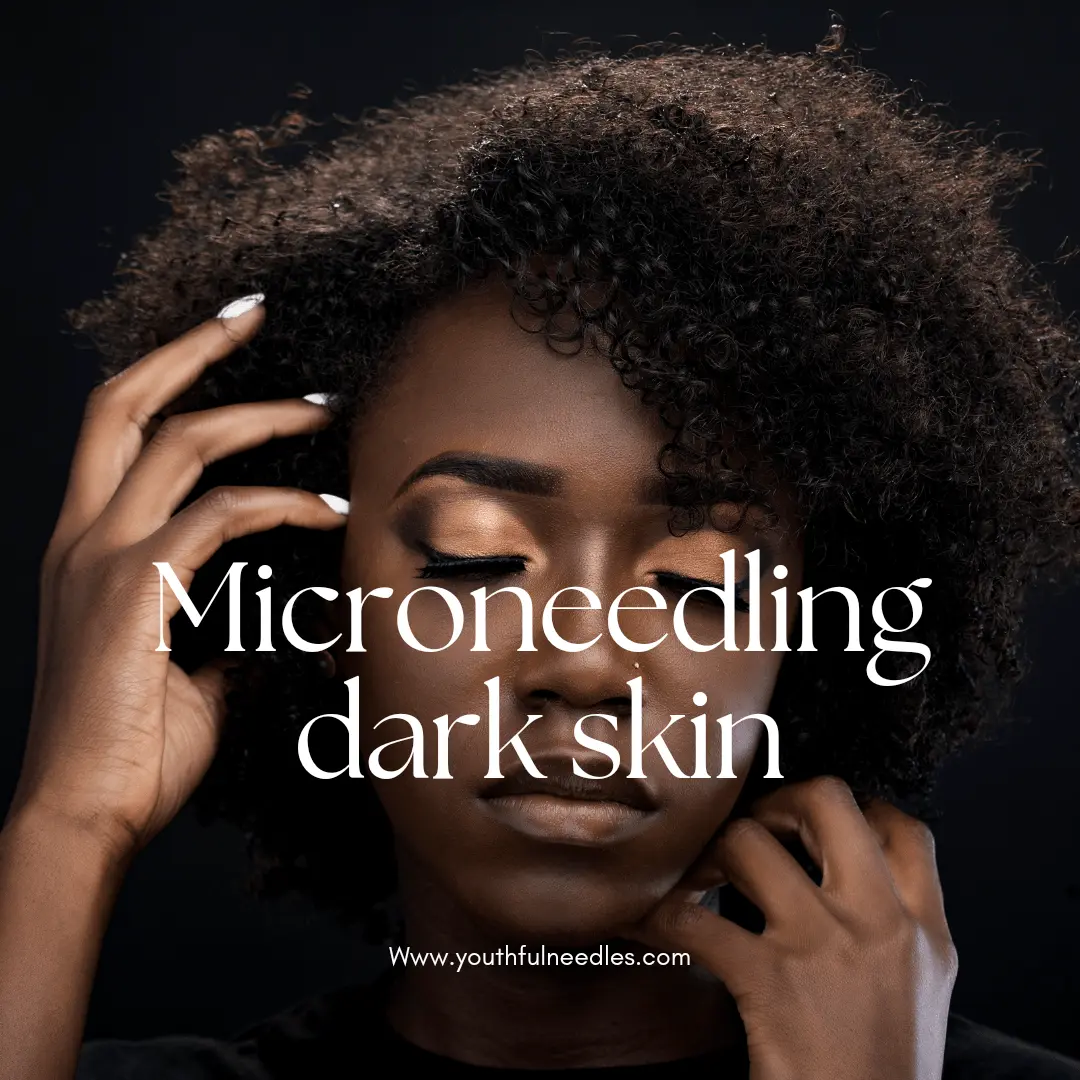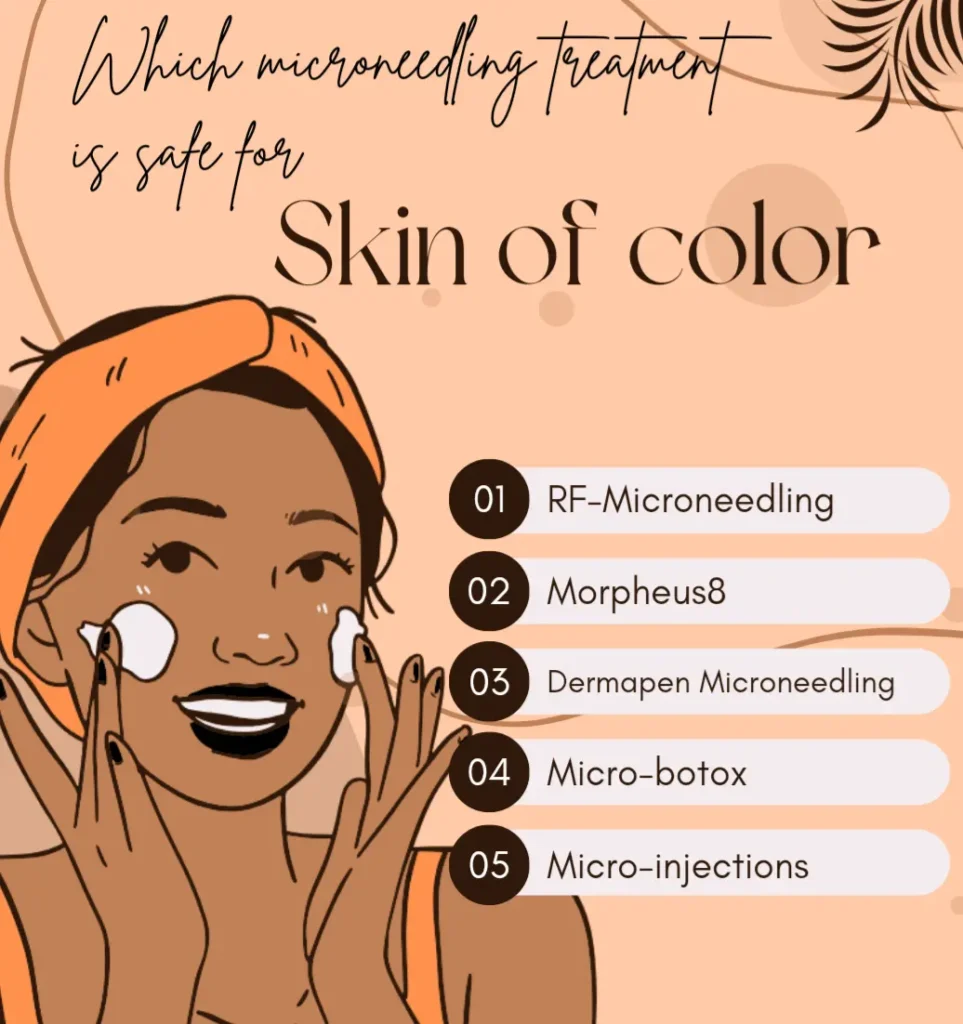Microneedling black Skin: Surprising facts
Updated: 30 November 2023
146

Microneedling black skin : A safer approach
Microneedling black skin can go wrong if not performed under the supervision of a professional. “Normal skin” and “skin of colour” refer to different skin types or conditions with several differences.
However, it’s important to note that these terms are general categories and don’t encompass all the possible variations in skin types and conditions among individuals. Additionally, it’s crucial to approach this topic with sensitivity, as discussions about skin colour can perpetuate stereotypes and biases. Here are some general differences:
- Pigmentation: One of the most noticeable differences between normal skin and skin colour is the level of pigmentation. The skin of colour typically contains more melanin, giving it its colour. This melanin provides some natural protection against the harmful effects of UV radiation from the sun. In contrast, normal skin may have less pigmentation and may be more prone to sunburn.
- Vulnerability to certain skin conditions: People with skin of colour may have a lower risk of developing certain skin conditions, such as skin cancer, as the higher melanin content provides some protection against UV damage. However, they may be more susceptible to specific pigment-related issues, such as hyperpigmentation (dark spots) or hypopigmentation (light spots).
- Skin care needs: Skin of colour may have different skin care needs than normal skin. For example, individuals with skin of colour may be more prone to issues like keloids or post-inflammatory hyperpigmentation (PIH), which can result from injuries or inflammation of the skin. Proper skincare routines and treatments may need to address these specific concerns.
- Cosmetic concerns: Skin of colour can react differently to cosmetic procedures like laser therapy or chemical peels. Microneedling black skin can sometimes lead to complications like post-inflammatory hyperpigmentation, so it’s essential to choose experienced healthcare providers knowledgeable about microneedling black skin.
- Differences in diagnosis and treatment: Skin conditions can sometimes present differently in individuals with skin of colour, which may lead to challenges in diagnosis. Healthcare providers must know these differences to ensure accurate diagnosis and appropriate treatment.

It’s important to emphasize that “skin of colour” is a broad term encompassing a wide range of skin tones and types, and this category has tremendous diversity. Understanding and appreciating these differences is essential in providing inclusive and effective healthcare and skincare.
Complications of microneedling black skin
Microneedling black skin or skin of colour, there are some unique complications to consider. Here’s a user-friendly breakdown:
- Hyperpigmentation:
- Keloid or Hypertrophic Scarring:
- Increased Sensitivity:
- Delayed Healing:
- Variable Results:
Tips for those considering microneedling on black skin:
Certainly, here’s a table outlining the major challenges of microneedling black skin and how these challenges can be overcome:
| Challenge | How to Overcome It |
|---|---|
| Risk of Post-Inflammatory Hyperpigmentation (PIH) in microneedling black skin | – Select a skilled practitioner experienced in microneedling black skin. – Pre-treat with skin-lightening agents. – Use lower needle depths and fewer passes during the procedure. – Apply post-treatment products that inhibit melanin production. – Strictly adhere to sun protection measures. |
| Uneven Results | – Ensure even pressure and spacing during microneedling. – Customize treatment depth and intensity based on individual skin needs. – For enhanced results, consider combining microneedling with other modalities, such as chemical peels or topical treatments. |
| Skin Sensitivity while microneedling black skin | – Conduct a thorough skin assessment before microneedling black skin to identify underlying skin conditions. – Use a numbing cream or local anesthesia to minimize discomfort during the procedure. – Advise patients to avoid skincare products containing irritants or active ingredients for a few days post-procedure. |
| Risk of Infection | – Maintain strict sterile protocols, including disinfecting the microneedling device and using disposable needles. – Educate patients about the difference in microneedling black skin, post-treatment hygiene, and keeping the treated area clean. – Prescribe topical antibiotics if necessary. |
| Downtime | – Inform patients about the expected downtime and potential side effects. – Recommend appropriate skincare products to help minimize downtime and accelerate healing in skin of color. – Offer options for less aggressive microneedling if minimal downtime is preferred. |
Successfully addressing these challenges requires a combination of careful patient selection, practitioner expertise, and customized treatment approaches. Prioritizing patient safety and desired outcomes is essential when microneedling black skin.
Microneedling black skin before and after
| Disclaimer |
|---|
Every individual’s skin is unique, so consult a qualified professional to assess your needs and potential risks. Can microneedling help with hyperpigmentation in black skin?Hyperpigmentation in black skin is a common dermatological concern characterized by the darkening of specific areas due to excess melanin production, the pigment responsible for skin colour. Acne, sun exposure, skin injuries, or hormonal changes can trigger it. This condition can result in uneven skin tone and dark spots or patches, making it a significant cosmetic concern for individuals with black skin. Proper skincare and targeted treatments are often necessary to address and reduce hyperpigmentation and achieve a more uniform complexion.Microneedling can either increase or decrease hyperpigmentation in dark skin, depending on how it is performed and the aftercare. When done by a skilled professional who takes proper precautions, microneedling can stimulate collagen production, promote skin renewal, and help reduce hyperpigmentation. However, if not performed correctly or if post-treatment care is inadequate, microneedling can potentially worsen hyperpigmentation, leading to post-inflammatory darkening of the skin. It’s essential to choose a qualified practitioner with experience treating dark skin and follow a strict post-treatment regimen to minimize the risk of adverse effects. What is the recovery time of microneedling black skin?The risk of post-inflammatory hyperpigmentation is a concern. This means that after microneedling, there is a higher likelihood of dark spots or patches developing in the treated areas, especially if the skin is exposed to UV radiation or if the procedure is not performed correctly. While the general recovery time for microneedling may be similar for individuals with different skin types, those with darker skin tones should pay extra attention to preventing and managing post-inflammatory hyperpigmentation to ensure a successful and safe recovery. Is micro needling for black skin beneficial?Yes, Microneedling can benefit black skin when performed by a skilled and experienced practitioner. This minimally invasive procedure can help improve various skin concerns, including acne scars, uneven skin tone, and fine lines.Microneedling does not change the colour of your skin; in fact, it improves the skin tone and texture by freshening it up. It makes the skin conditions better and makes your skin look rejuvenated. Microneedling black skin is quite challenging as it requires How vital is sun protection after microneedling black skin?Sun damages the skin and makes an individual more prone to skin-related diseases. Similarly, if proper preventive measures are not taken after microneedling on black skin, it can lead to – Dark spots – Melasma – Deep wrinkles – Delayed healing – Pigmentation |
Please Write Your Comments